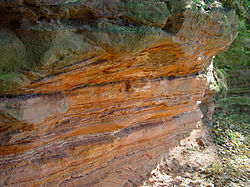
Back الثلاثي المبكر Arabic Triásicu Inferior AST Buntsandstein German Triásico Inferior Spanish Behe Triasiko Basque تریاس پیشین Persian Varhaistriaskausi Finnish טריאס תחתון HE Kora triász Hungarian Trias Awal ID
| Early/Lower Triassic | |||||||||||||||||||||||
|---|---|---|---|---|---|---|---|---|---|---|---|---|---|---|---|---|---|---|---|---|---|---|---|
 Sandstone from the Lower Triassic Series | |||||||||||||||||||||||
| Chronology | |||||||||||||||||||||||
| |||||||||||||||||||||||
| Etymology | |||||||||||||||||||||||
| Chronostratigraphic name | Lower Triassic | ||||||||||||||||||||||
| Geochronological name | Early Triassic | ||||||||||||||||||||||
| Name formality | Formal | ||||||||||||||||||||||
| Usage information | |||||||||||||||||||||||
| Celestial body | Earth | ||||||||||||||||||||||
| Regional usage | Global (ICS) | ||||||||||||||||||||||
| Time scale(s) used | ICS Time Scale | ||||||||||||||||||||||
| Definition | |||||||||||||||||||||||
| Chronological unit | Epoch | ||||||||||||||||||||||
| Stratigraphic unit | Series | ||||||||||||||||||||||
| Time span formality | Formal | ||||||||||||||||||||||
| Lower boundary definition | FAD of the Conodont Hindeodus parvus | ||||||||||||||||||||||
| Lower boundary GSSP | Meishan, Zhejiang, China 31°04′47″N 119°42′21″E / 31.0798°N 119.7058°E | ||||||||||||||||||||||
| Lower GSSP ratified | 2001[6] | ||||||||||||||||||||||
| Upper boundary definition | Not formally defined | ||||||||||||||||||||||
| Upper boundary definition candidates |
| ||||||||||||||||||||||
| Upper boundary GSSP candidate section(s) |
| ||||||||||||||||||||||
The Early Triassic is the first of three epochs of the Triassic Period of the geologic timescale. It spans the time between 251.9 Ma and 247.2 Ma (million years ago). Rocks from this epoch are collectively known as the Lower Triassic Series, which is a unit in chronostratigraphy. The Early Triassic is the oldest epoch of the Mesozoic Era. It is preceded by the Lopingian Epoch (late Permian, Paleozoic Era) and followed by the Middle Triassic Epoch. The Early Triassic is divided into the Induan and Olenekian ages. The Induan is subdivided into the Griesbachian and Dienerian subages and the Olenekian is subdivided into the Smithian and Spathian subages.[7]
The Lower Triassic series is coeval with the Scythian Stage, which is today not included in the official timescales but can be found in older literature. In Europe, most of the Lower Triassic is composed of Buntsandstein, a lithostratigraphic unit of continental red beds.[citation needed]
The Early Triassic and partly also the Middle Triassic span the interval of biotic recovery from the Permian-Triassic extinction event, the most severe mass extinction event in Earth's history.[8][9][10] A second extinction event, the Smithian-Spathian boundary event, occurred during the Olenekian.[11] A third extinction event occurred at the Olenekian-Anisian boundary, marking the end of the Early Triassic epoch.[12]
- ^ Widmann, Philipp; Bucher, Hugo; Leu, Marc; et al. (2020). "Dynamics of the Largest Carbon Isotope Excursion During the Early Triassic Biotic Recovery". Frontiers in Earth Science. 8 (196): 196. Bibcode:2020FrEaS...8..196W. doi:10.3389/feart.2020.00196.
- ^ McElwain, J. C.; Punyasena, S. W. (2007). "Mass extinction events and the plant fossil record". Trends in Ecology & Evolution. 22 (10): 548–557. doi:10.1016/j.tree.2007.09.003. PMID 17919771.
- ^ Retallack, G. J.; Veevers, J.; Morante, R. (1996). "Global coal gap between Permian–Triassic extinctions and middle Triassic recovery of peat forming plants". GSA Bulletin. 108 (2): 195–207. Bibcode:1996GSAB..108..195R. doi:10.1130/0016-7606(1996)108<0195:GCGBPT>2.3.CO;2. Retrieved 2007-09-29.
- ^ Payne, J. L.; Lehrmann, D. J.; Wei, J.; Orchard, M. J.; Schrag, D. P.; Knoll, A. H. (2004). "Large Perturbations of the Carbon Cycle During Recovery from the End-Permian Extinction". Science. 305 (5683): 506–9. Bibcode:2004Sci...305..506P. doi:10.1126/science.1097023. PMID 15273391. S2CID 35498132.
- ^ Ogg, James G.; Ogg, Gabi M.; Gradstein, Felix M. (2016). "Triassic". A Concise Geologic Time Scale: 2016. Elsevier. pp. 133–149. ISBN 978-0-444-63771-0.
- ^ Hongfu, Yin; Kexin, Zhang; Jinnan, Tong; Zunyi, Yang; Shunbao, Wu (June 2001). "The Global Stratotype Section and Point (GSSP) of the Permian-Triassic Boundary" (PDF). Episodes. 24 (2): 102–114. doi:10.18814/epiiugs/2001/v24i2/004. Archived (PDF) from the original on 28 August 2021. Retrieved 8 December 2020.
- ^ Tozer, Edward T. (1965). Lower Triassic stages and ammonoid zones of arctic Canada. Geological Survey of Canada. OCLC 606894884.
- ^ Cite error: The named reference
PayneKump2007EPSLwas invoked but never defined (see the help page). - ^ Feng, Xueqian; Chen, Zhong-Qiang; Woods, Adam; Fang, Yuheng (15 November 2017). "A Smithian (Early Triassic) ichnoassemblage from Lichuan, Hubei Province, South China: Implications for biotic recovery after the latest Permian mass extinction". Palaeogeography, Palaeoclimatology, Palaeoecology. 486: 123–141. Bibcode:2017PPP...486..123F. doi:10.1016/j.palaeo.2017.03.003. Archived from the original on 21 January 2023. Retrieved 20 January 2023.
- ^ Matamales-Andreu, Rafel; Peñalver, Enrique; Mujal, Eudald; Oms, Oriol; Scholze, Frank; Juárez, Josep; Galobart, Àngel; Fortuny, Josep (November 2021). "Early–Middle Triassic fluvial ecosystems of Mallorca (Balearic Islands): Biotic communities and environmental evolution in the equatorial western peri-Tethys". Earth-Science Reviews. 222: 103783. Bibcode:2021ESRv..22203783M. doi:10.1016/j.earscirev.2021.103783. S2CID 238730784. Archived from the original on 19 December 2022. Retrieved 8 December 2022.
- ^ Widmann, Philipp; Bucher, Hugo; Leu, Marc; Vennemann, Torsten; Bagherpour, Borhan; Schneebeli-Hermann, Elke; Goudemand, Nicolas; Schaltegger, Urs (2020). "Dynamics of the Largest Carbon Isotope Excursion During the Early Triassic Biotic Recovery". Frontiers in Earth Science. 8 (196): 196. Bibcode:2020FrEaS...8..196W. doi:10.3389/feart.2020.00196.
- ^ Song, Haijin; Song, Huyue; Tong, Jinnan; Gordon, Gwyneth W.; Wignall, Paul B.; Tian, Li; Zheng, Wang; Algeo, Thomas J.; Liang, Lei; Bai, Ruoyu; Wu, Kui; Anbar, Ariel D. (20 February 2021). "Conodont calcium isotopic evidence for multiple shelf acidification events during the Early Triassic". Chemical Geology. 562: 120038. Bibcode:2021ChGeo.56220038S. doi:10.1016/j.chemgeo.2020.120038. S2CID 233915627. Archived from the original on 12 December 2022. Retrieved 12 December 2022.
© MMXXIII Rich X Search. We shall prevail. All rights reserved. Rich X Search